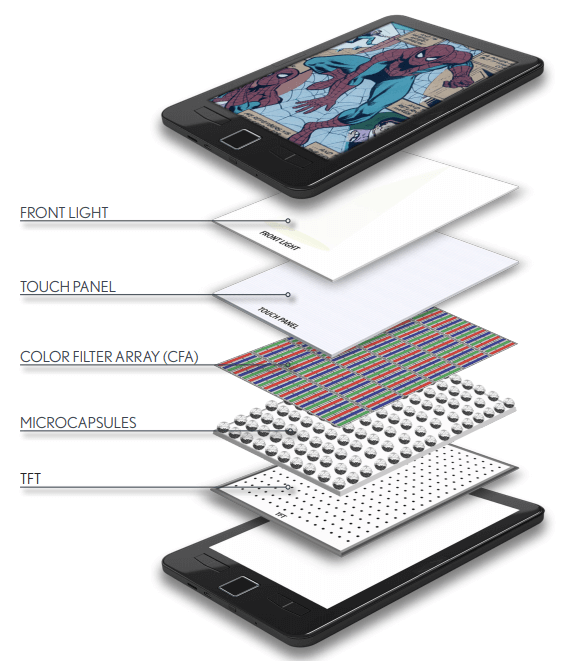In the rapid development of digital display technology, electronic paper technology has emerged, leading a new era of digital reading and information display with its unique display principle and eye-catching advantages. Unlike traditional LCDs, e-paper features a natural display effect that simulates paper, providing users with an eye-friendly, high-contrast reading experience. This article will delve into the display principles and advantages of electronic paper, and let us explore together how electronic paper redefines digital display.
Structure of Electronic Paper:

1. Substrate:
The substrate of electronic paper serves as the foundational support structure for the screen. Typically made of flexible materials such as plastic or glass, this layer provides stability and structural support to the screen, impacting the flexibility and thinness of the electronic paper. The substrate often includes circuits and electrodes for creating an electric field in the microcapsule layer, facilitating the modulation of charges within the microcapsules.
2. Microcapsule Layer:
The microcapsule layer is a crucial component of electronic paper, containing numerous tiny capsules. Each capsule houses minute black and white particles capable of movement and possessing positive or negative charges. To achieve different colors on the electronic paper, an electric field is applied within the microcapsule layer, modulating the positions of the particles and thereby achieving variations in black and white. This layer's distinctive feature lies in its reflection of light rather than emission, resulting in extremely low power consumption.
3.Top Encapsulation:
To protect the microcapsule layer and optimize optical performance, electronic paper typically includes a top encapsulation layer. This transparent layer ensures that light can penetrate and reach the microcapsule layer. The design of the encapsulation layer helps prevent the infiltration of moisture and dust while providing additional protection for the electronic paper screen. The quality and transparency of the encapsulation layer directly impact the display quality and durability of the electronic paper screen.
Principles of Electronic Paper:

1. Microcapsule Technology:
At the core of electronic paper lies microcapsule technology. Tiny capsules containing black and white particles are suspended in a transparent liquid. Each capsule carries a charge, with black particles negatively charged and white particles positively charged. When an electric field is applied, the particles within the capsules move, causing a change in color. This technology mimics the display of text and images on paper by utilizing reflection rather than emission, contributing to the high readability and low power consumption characteristics of electronic paper.
2. Charge Modulation:
Each pixel on an electronic paper screen consists of small capacitors. By applying a charge to these capacitors, the position of color particles can be altered, enabling black-and-white displays. Specifically, when a positive charge is applied, particles are attracted into the electric field, resulting in a white pixel. Conversely, when a negative charge is applied, particles are repelled, creating a black pixel. This charge modulation mechanism allows electronic paper to maintain a display state with minimal energy consumption.
3. Optical Modulation:
Optical modulation is crucial for achieving high contrast and a wide viewing angle in electronic paper. By adjusting the position of particles within electronic paper, the scattering and transmission of light can be modified, influencing the propagation of visible light. This modulation mechanism enables electronic paper to provide clear displays under various lighting conditions, while also offering a response speed similar to paper. Optical modulation is fundamental to electronic paper's characteristics of glare-free, easy readability.
In the ever-evolving landscape of digital displays, electronic paper emerges as a beacon of innovation. Its sleek structure and ingenious principles not only deliver a visual feast but also hint at a future where technology seamlessly integrates with our daily lives. As we bid farewell to this exploration, keep an eye on the horizon—electronic paper is just getting started, promising a future where screens are not just seen but experienced in a whole new light.
The 8 inch displays might be affected and delay for an accident.
This is the project management of how sinocrystal handle your customized project relate to displays.
New iPhone 13 Series will use On-Cell OLED Displays. And it that will be launched in the second half of this year will be exclusively supplied by Samsung Display (SDC)
A complete guide to LCD display connection methods, including SPI, I2C, RGB, MIPI, LVDS interfaces and physical mounting options. Learn how to connect monochrome and TFT LCDs to your development board or product housing.
This week, we had the pleasure of hosting an esteemed international client at our LCD display manufacturing facility in Dongguan. Guided by our team, the client visited key production areas such as the fully automated COG bonding line, backlight assembly area, full lamination workshop, and final product aging test section. They highly appreciated our production capacity, strict quality control, and engineering expertise. This visit strengthened mutual trust and set the stage for future collabora
The ILI9881C is a high-performance a-Si TFT LCD single-chip driver developed by ILI Technology Corp. With its excellent display performance and flexible configuration options, this driver meets the modern display device requirements for high resolution and color accuracy. This article will detail the supported resolutions, interfaces, and power supply voltage of the ILI9881C.
The GC9307, a TFT LCD driver with QVGA resolution, has gained widespread use among LCD module manufacturers since its launch. Sinocrystal are excited to share a series of practical insights we have gathered from using the GC9307 driver.